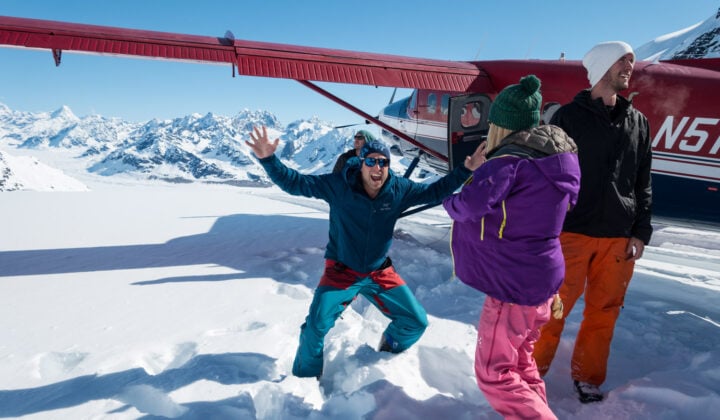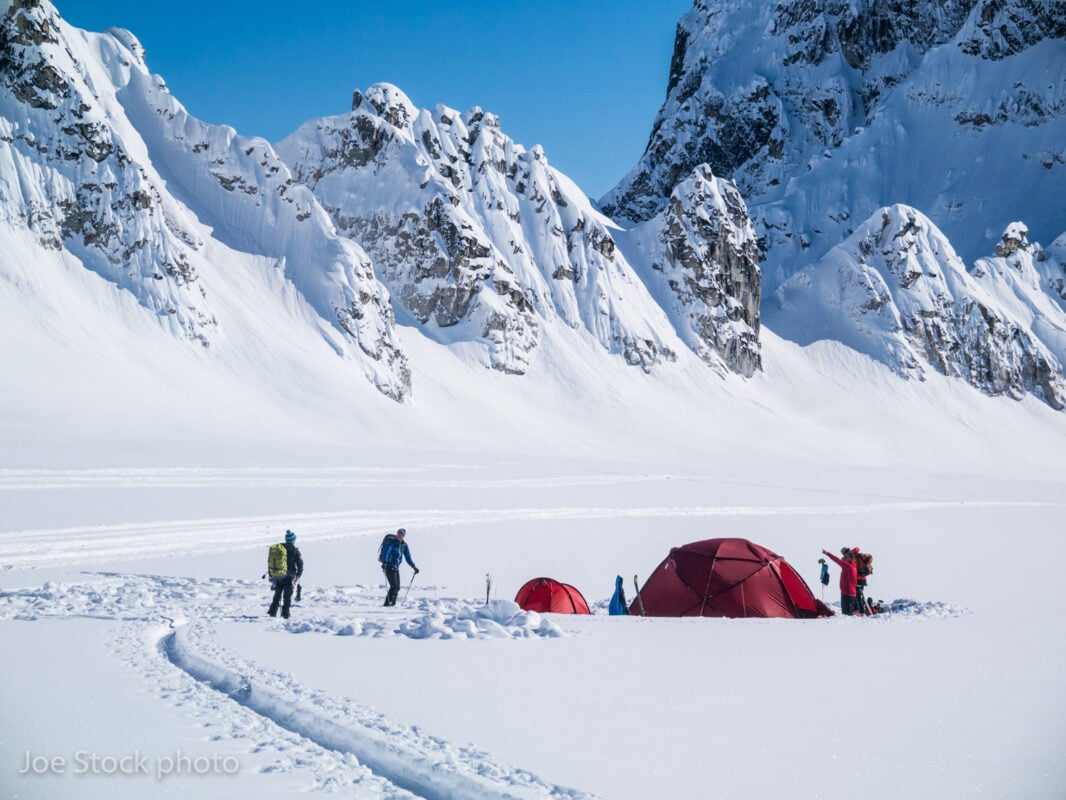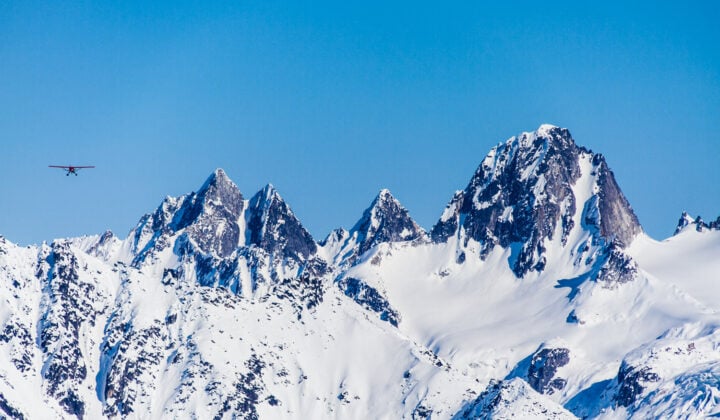Make sure to arrive in Anchorage a day prior to flying out. Meet up with your team and your hosts at 5 pm at your B&B. We’ll go through last-minute gear checks and head to AMH and REI to buy whatever you might need. Then we’ll have dinner at a brew pub, where we’ll get to know each other and talk about tomorrow.
-
Let’s fly into the Central Alaska Range and have the time of our lives in the remote, pristine wilderness of these rugged mountains. Central Alaska Range has the biggest mountains in North America, including Denali at 20,320 ft. But at lower elevations, you’ll find deep and often stable snowpack combined with various terrain options. Our home for the week will be a base camp in the middle of nowhere—we’ll be surrounded by silence, sleep under the star-studded skies, and head out skiing whenever we feel like it.
-
-
We’ll meet up at the B&B at 7 am, drive 2.5 hours to Talkeetna and load gear onto the Talkeetna Air Taxi bush plane. The flight to the Alaska Range takes about 45 minutes. After setting up a fat base camp, we’ll review avalanche and crevasse companion rescue. If time allows, we’ll even go for an evening ski to warm up.
-
With a base camp on the glacier, each morning we’ll get up, have a hearty breakfast, and go straight to skiing—and we’ll continue skiing as long as we have the energy and if conditions allow. We can expect a deep and often stable snowpack with terrain perfect for skiing. Terrain options exist for all abilities, from moderate glacier runs to steep chutes. Most of the skiing will be on glaciers, but these are cirque glaciers that hang above the bigger valley glaciers. These cirque glaciers have smaller crevasses, which typically allow us to ski downhill unroped.
-
We’ll use this last day to ski in the morning. Once we’re packed, we’ll fly back to Talkeetna for burgers and beer at the Denali Brewery. We’ll drive back to Anchorage or stay in Talkeetna. Say goodbye to your team and your hosts!
-
Please keep in mind that Alaska requires more flexibility than elsewhere. We will be on the mountain’s schedule, not yours. It’s possible that we shift to a different ski zone or even fly out of the powder-coated mountains under blue skies because the guide feels the avalanche danger is too high. Regarding air taxis—they add delays. About 50% of the fly-in trips have some flight delay, which may be multiple days. Of course, our goal is to minimize these delays and maximize trip success.
-
-
-
What you get on this adventure:
-
- AMGA/IFMGA Mountain Guide Joe Stock + one more licensed Mountain Guide
- 6-day Denali Ski Base Camp adventure
- Accommodation during the tour
- Glacier air taxi
- All food on the mountain
- Group tent & gear
- Base camp tent for entire group
- Clean Mountain Cans for latrine
- Group cooking gear
- First aid, repair, and navigation kit
- Rescue sled and shelter
- Solar panels for charging batteries
- Emergency communication
- Ropes
- Navigation, first aid, and repair kits
- Emergency shelter and communication
What’s not included:
-
- Transportation to Alaska
- Transportation between Anchorage and Talkeetna
- Accommodation and food off the mountain
- Technical backcountry ski touring equipment
- Rescue and trip insurance
- Guide gratuities — optional
-
-
During your time on the glacier, you will stay at a base camp—fun and comfortable, but not luxurious. You will sleep and cook altogether in a six-person Hilleberg tent that is tall enough for standing. Additional smaller tents are available for bigger groups if you want privacy.
The food isn’t gourmet, but plentiful and the kind you crave after a big day of skiing. The latrine will be a Denali Clean Mountain Can from the Park Service, so it’s possible to transport the waste out the mountains.
-
Where exactly we go in the Alaska Range depends on conditions and your interest. We won’t make the final decision until minutes before getting on the plane. You can rest assured that we’ll have a true expert by our side, Joe Stock, AMGA/IFMGA Mountain guide with 75+ trips spread over 20+ years of experience into the Central Alaska Range.
Terrain options exist for all abilities, from moderate glacier runs to steep chutes. Most of the skiing will be on glaciers, but these are cirque glaciers that hang above the bigger valley glaciers. These cirque glaciers have smaller crevasses, which typically allow us to ski downhill unroped.
-
In order to enjoy this adventure, you need to have a great level of fitness. You will be on your feet for six days. This tour is ideal for intermediate to experienced skiers, as you will need to manage controlled descents in variable conditions and have good endurance for consecutive full days in the mountains. All participants should feel comfortable on challenging blue or black-level resort runs and be able to carry a loaded daypack while skinning up variable degrees of terrain.
You should also have avalanche rescue practice. Previous winter camping experience is helpful, but not required. This goes for previous glacier travel as well—helpful, but not required.
Keep in mind that backcountry skiing requires a combination of endurance and strength. Endurance comes from having your heart rate elevated for an hour or more doing sports such as skiing, running or cycling. This endurance training allows you to ski all day in the mountains. A good way to achieve strength is through core fitness training such as Crossfit, P90X, and Mountain Athlete. These intense and short workouts are important for injury prevention and allow you to carry a ski mountaineering pack while making big runs.
-
This Denali Ski Base Camp requires you to have previous backcountry skiing experience, so it’s not suitable for beginners. It’s ideal for intermediate to advanced backcountry skiers. The terrain is challenging and technical, requiring controlled descents in sometimes tricky environments.
Apart from previous backcountry skiing experience, you should also have recent avalanche rescue practice.
-
Ski gear
-
- Skis — opt for lightweight alpine touring (AT) skis with 100-110 mm underfoot OR splitboard & bindings (Spark bindings for backcountry use or Phantom for splitboard mountaineering with hard boots)
- Bindings (for skis) — AT tech-style bindings preferred (heavy, sidecountry, frame bindings are not recommended as they will limit your runs no matter how strong you are)
- Binding repair kit
- Leashes — brakes are not reliable on firm slopes, use a key ring on your boot to make the leash releasable (if not leashes, brakes)
- Boots — tech-compatible AT boots, hard boots recommended for splitboard mountaineering
- Skins — cut to fit the ski base with metal edges showing, tail clip required
- Poles
- Beacon — must be less than 10 years old and modern with three antennas
- Shovel — metal only
- Probe — 300 cm or longer
- Ski strap — no Velcro, store wrapped around a ski pole
- Ski crampons
- Helmet — optional, but recommended
Top layers
-
- Hardshell jacket — since it’s a shell, and not an insulating layer, opt for the lightest option
- Insulated jacket — with a hood
- Softshell jacket — or windshirt
- Expedition weight top
- Long underwear top
Bottom layers
-
- Hardshell pants — hardshell leg wear is more versatile than softshell
- Long underwear bottom
- Softshell pants — optional, bring in conjunction with long underwear and hardshell pants
- Belt — or suspenders
- Warm socks
Head and hand wear
-
- Light gloves
- Heavy gloves
- Mittens
- Warm hat
- Face cover
- Goggles
- Sunglasses
- Sunhat
Personal gear
-
- Backpack — 30-45 liters, under 3 lbs
- Headlamp — small and light, with batteries that match your beacon
- Personal medication
- Sunscreen — at least SPF 30
- Lip balm with SPF — at least SPF 30
- Water bottles — one or two, one-liter wide-mouth bottles (no hydration systems as they freeze, explode, and leak)
- Toilet paper
Ski mountaineering gear
-
- Ice ax — light and short mountaineering ax
- Crampons — aluminum, ultra-light crampons without anti-ball plates are best
- Harness — lightweight with belay loop and gear loops
- 2 Prusik loops — 150 cm (5-foot) lengths of 5 mm accessory cord tied into a loop with a flemish bend
- Cordelette — 6 m (20 feet) length of 5 mm accessory cord tied into a loop with a flemish bend (if you don’t have prusiks or cordelette, bring 10 m (33 ft) of 5 mm accessory cord and we’ll cut it to length. Get soft and supple cord)
- 4 locking carabiners — munter (pear-shaped) biner for belaying and rappelling
- 4 non-locking carabiners
- Pulley-progress capture — optional
- Belay device — recommended
- Ice screw — recommended
- One self-arrest ski pole
Base camp gear
-
- Travel duffel — plastic coated
- Sleeping bag — with a compression stuff sack, to -0°F
- Foam pad — to combine with your air mattress for extra insulation
- Air mattress — must be RP or greater
- Camp boots — knee-high and waterproof, low-top shoes
- Pee bottle (because storms can limit outside latrine use, 1 liter or larger)
- Pee funnel (required for women)
- Toiletry bag —toothbrush, toothpaste, wet wipes, foot powder, soap, cosmetics…
- Camp entertainment — music, book, podcast…
- Spoon, bowl, mug, pint bottle
- Clean base layers
- Booties
- Puff pants
- Battery
-
-
All mandatory gear can be rented if you don’t have your own. You can rent:
-
- Avalanche safety pack (including backpack, beacon, shovel and probe)
- Alpine touring or telemark skis, and touring boots and poles
- Splitboards
The day prior to flying out you will meet up with your team and your hosts in Anchorage at 5 pm. There you will have the chance to make some last minute gear purchases at AMH and REI. If you require more equipment, let us know in advance and we can help arrange it for you. We recommend Alaska Outdoor Gear (outdoor gear), Alaska Mountaineering & Hiking (ski gear), and Blue and Goldak (splitboards).
-
-
The maximum group size for this skiing adventure in Denali Ski Base Camp is set at 6 people with one expert guide.
-
To get to Anchorage, the starting point of your adventure, fly into Ted Stevens Anchorage International Airport (ANC). Meet your hosts a day prior to starting your skiing adventure in Anchorage at 5 pm. The exact meet-up location in Anchorage will be determined.
-




